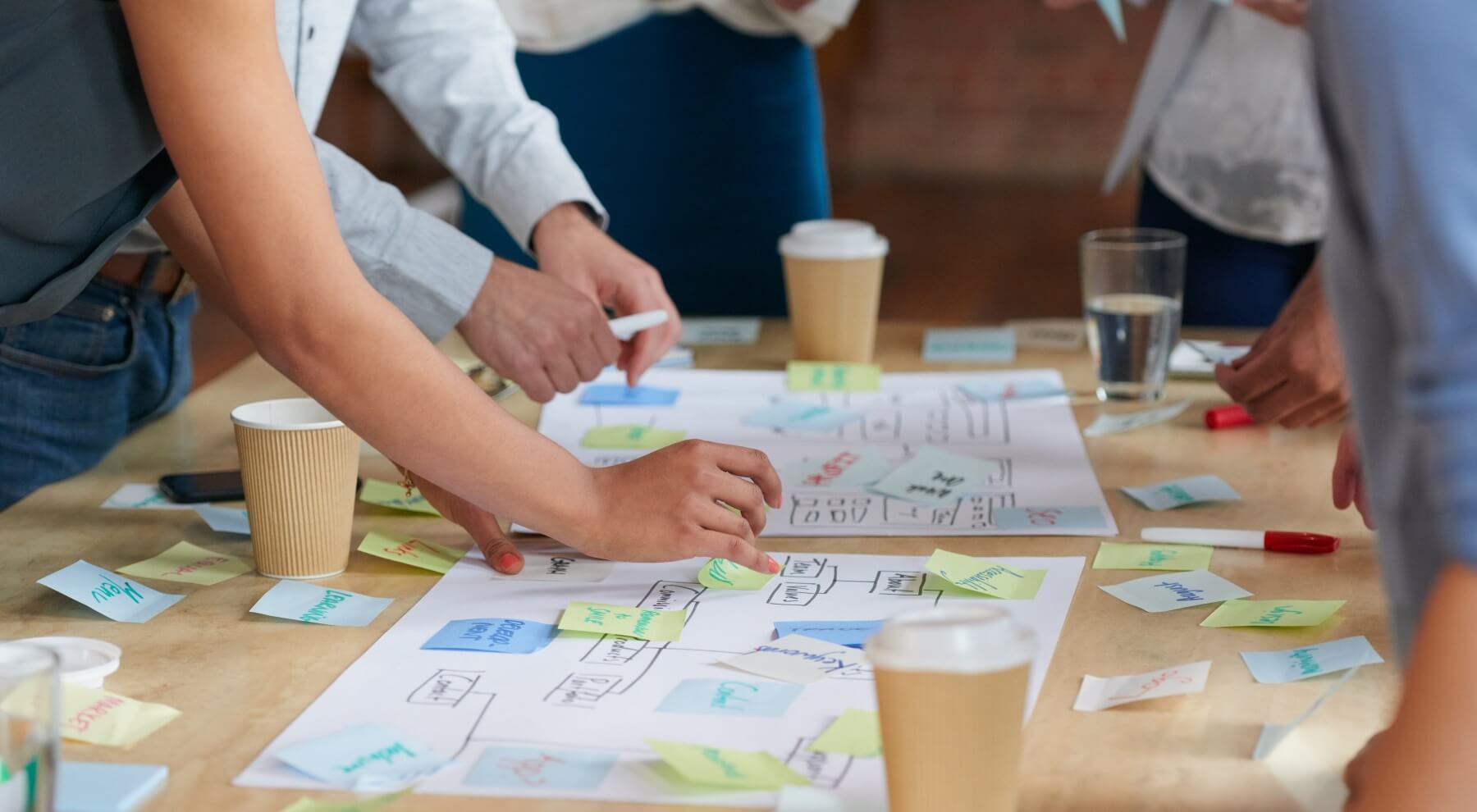Is it possible to boost innovation quickly and improve employee engagement at the same time? Advocates of innovation challenges or calls for ideas certainly believe so.
This method of collaborative innovation has become popular for proven results in generating ideas on targeted topics. However, careful preparation is required and key stages must be followed to guarantee the success of a call for ideas while genuinely increasing employee engagement.
Your guide to collaborative innovation challenges
You may have heard of it referred to as an innovation challenge, a call for ideas, a hackathon, a startup weekend and an innovation boot camp: the process is the same. It brings together people from different backgrounds to consider a clearly-defined topic and gives free rein to their collective intelligence and creativity within a given time frame.
Innovation challenges are the best example of the application of open, collaborative innovation. By encouraging dialogue and exchange between different business units and across different management levels, they are not only a fun, new way to innovate and address practical issues differently, they also form a vital part of any management tool kit.
Innovation challenges require careful preparation
To ensure success and deliver employee engagement, the challenge and its objectives must be clearly defined. Start by properly targeting the people likely to participate in the challenge for a set period of time based on the relevant issue. It makes sense to open challenges to everyone as long as the subject matter enables everyone to take part.
It is also crucial to involve senior management as challenges sometimes require a real culture change to allow employees to speak and be heard. The impact is always stronger and staff participation higher if senior management is actively involved in the challenge.
This may seem obvious, but some false beliefs still need pointing out.
Bust the myths about innovation challenges in business
To really understand why the next steps are useful, it’s helpful to highlight some prejudices which might minimize the impact of your challenge:
Myth 1: “Suggest broad themes to receive lots of ideas”
The quantity of ideas is not the end game. The aim is to innovate – transform ideas into projects – or even better, into revenue! In other words, the aim is value creation. You need to set strategic goals where you want or would benefit from investing resources to implement the best suggestions.
Myth 2: “It’s a digital suggestion box”
A suggestion box is like a black box. The envelope you slip inside remains invisible and its future is uncertain. The innovation challenge shines a light on ideas. It’s a way of really sharing information.
Myth 3: “Good intentions are enough”
Wrong! In the midst of busy workloads and commitments, there is no time for good intentions. If good intentions were enough, everyone would innovate spontaneously, making the most of the willing and available resources in a world that simply doesn’t exist. An innovation challenge is a corporate project and needs to be managed as such, assigning roles and making commitments.
Myth 4: “It’s all over once the winners are announced”
In fact, that’s just the beginning. Harness the right resources and energy to transform initiatives into projects. Senior management buy-in is essential at this stage.
The 4 steps in a successful innovation challenge
Once you’ve busted the myths, here are the different steps to launch your challenge.
1Determine the rules and timetable
It is important to clearly set out the rules of the challenge: the topic or issue to be resolved, the duration, how ideas are to be presented, how the best ideas are selected, and any rewards on offer. An innovation challenge does not necessarily entail a specific venue over a short period of time, which might put teams under pressure. While momentum might be important, extending the challenge time line allows people more time for reflection and creativity. More people can get involved in the process by allowing everyone to find time in their often busy schedules.
2Select the right tools for the job
Digital transformation is making collaboration the new normal at work. Innovation challenges are no exception. A shared workspace is needed, giving access to all the information necessary and where all the ideas can be pooled. This means an ideation platform where employees can formally submit their proposals and encourage others to enhance their ideas completely transparently. The secret to an innovation challenge lies in the opportunity for sharing between teams, departments, businesses, countries, and subsidiaries which could not be done without the help of a tool. We will come back to selection criteria for choosing this tool.
3Communicate and emphasize both the benefits and challenges to participants
To motivate teams, start communicating and raising awareness: keep all employees informed about the challenge, organize meetings and presentations. Involve local managers and promote the challenge through the company’s internal communication channels, such as Intranet, newsletters, and posters. Explain the aims, rules, and potential wins. Participants will be much more motivated if they know they are likely to see their idea converted into a real change initiative. They meet new people, work outside their comfort zone, and discover new aspects of the business. Communication about the event should include this participative dimension just as much as the actual issues and objectives to be achieved. Communication must be continuous, driven by senior management, and not stop when the challenge stops. Participants must be kept informed of developments and the outcomes of change initiatives.
4Evaluate all avenues, follow the best, and communicate about the whole process
To evaluate proposals and select the most promising, set up an assessment committee to analyze ideas according to a framework of criteria. Even once you’ve identified the winners and those that don’t make the cut, you can expect various types of ideas in an innovation challenge:
- Nuggets, golden ideas where the value created for the business will be significant. However, these rarely amount to more than 1% or 2% of the initiatives submitted. There are also projects that unify everyone, and it is worth including them in the winners.
- Quick wins, less disruptive and easier to implement but nonetheless with real benefits for the business. Usually quick, small changes that added together have equally significant benefits.
- “Other”, sources of minor day-to-day improvements, albeit not worthy of widespread announcements. They nonetheless warrant tracking in an idea management system and inclusion within a long-term evaluation and monitoring process. An innovation challenge can serve to establish the foundations of a broader culture of workplace creativity, to be maintained over the long term.
Select a tool to organize ideas and teams
IDhall – A solution for rolling out the steps of your innovation challenge
When it comes to choosing an innovation challenge tool, it can be difficult to anticipate and make the right choice. Try considering the following criteria:
- User-friendliness: The tool must be user-friendly and easy to use for participants and organizers. The interface should be intuitive, with simple features for submitting ideas, exchanging information, and monitoring progress.
- Collaboration features: The perfect tool makes collaboration between participants easy, enabling sharing of ideas, comments, and documents.
- Process management: The tool should effectively manage the process of submitting ideas, assessment, selection, and monitoring proposals. It can include features such as customizable work flows, evaluation and scoring mechanisms, and dashboards for monitoring progress and results.
- Data security: Ensure the tool offers sufficient security to protect sensitive company, personal, and project data.
- Support: More than just a tool, support is also crucial.
IDhall, with its user-friendly, intuitive interface, makes submitting ideas easy and lets you monitor initiatives and progress, while ensuring data integrity. The software has been used by companies of all sizes and across all sectors since 2004. This experience means we can support our clients and provide reliable advice about innovation and progress.
Collaborative innovation challenges – some good examples
Here are some concrete examples of successful innovation challenges to inspire you.
How DRSM Occitanie used a call for ideas to underpin its transformation project
DRSM Occitanie, an arm of the national public health system in the Occitanie region, embarked on a major transformation project. To strengthen the process locally and generate more initiatives, DRSM Occitanie organised a call for ideas from its staff. To find out more, read how Adélaïde Beaude successfully used IDhall to collect new ideas and build an innovative road map.
SNCF’s disability initiative challenge
As part of European Disability Employment Week in 2019, SNCF launched a disability initiative challenge among its employees. It aimed firstly to improve the day-to-day experience of employees with disabilities, and secondly to change how disability is viewed by employees. Seven winners received a trophy rewarding the spirit of initiative and solidarity shown by the employees who put these measures in place.
Air France’s innovation challenge
The Customer Priority Hackathon is a challenge launched by Air France aimed at creating a mobile app designed to improve the passenger experience in case of unforeseen circumstances. The innovation process is central to Air France’s culture, so the company ran a well-designed challenge with:
- Personas to bring the challenge to life with examples of unforeseen circumstances;
- A clear brief, with access to a comprehensive data pool, but only 48 hours to build a convincing argument; and
- An attractive prize of a long-haul return flight chosen from 10 worldwide destinations.
Huisman’s sustainable development challenge
To encourage sustainable development within the company, Huisman created the Proteus Challenge, an ideas competition based on sustainable development and open to all employees in 2022.
Proteus is a Greek god associated with transformation. Participants were invited to come up with new ideas and solutions in different sectors both inside and outside the company to reduce the company’s environmental impact. A winner was selected from each sector. Timon’s idea is an innovation accelerator. “A carbon footprint label that measures the environmental impact of developing and manufacturing our products and promotes ways to reduce it. This idea has already contributed to developing the sustainable impact assessment we recently announced.”
What are you waiting for to organize your challenge?
Apart from the benefits of collecting and listening to employees’ good ideas, innovation challenges can also reinvigorate employee engagement which we know boosts company development.
Innovation challenges encourage openness internally and help to break down silo effects by combining different groups of employees to meet a shared objective of generating ideas. They can also serve to identify talents, both internally and externally, and help to disseminate a culture of innovation and collaboration. Innovation challenges encourage situations where employees work together. Even those who aren’t capable of suggesting ideas unprompted can help by offering alternative viewpoints to fine tune initial ideas.
Challenges naturally improve employee engagement which is why it’s important to support the process at the end of the challenge so it doesn’t fizzle out. Keep participants regularly informed about the practical implementation of initiatives and run a more regular continuous participative innovation process.
Are you looking to organize an innovation challenge? Discover how to integrate in a genuine innovation culture in your organization.

This article was originally published on June 18, 2019 and was updated on May 17, 2023.




